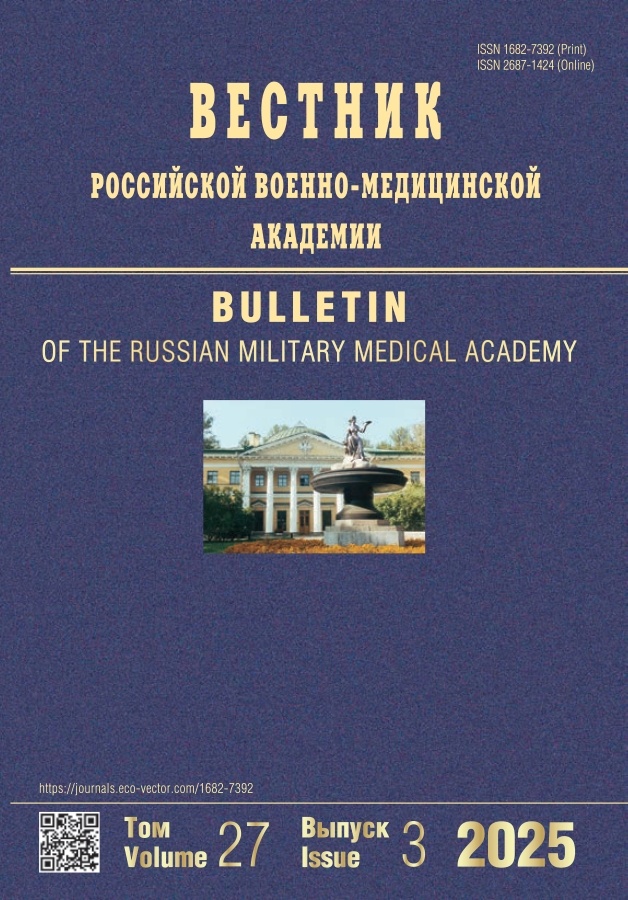Analysis of airmen disadaption factors after combat stress exposure
- 作者: Schegol’kov A.M.1, Blaginin A.A.2, Fisun A.Y.3, Cherkashin D.V.2, Makiev R.G.1, Gornov S.V.1, Kutelev G.G.2
-
隶属关系:
- Branch of the Military medical academy of S.M. Kirov
- Military medical academy of S.M. Kirov
- State scientific-research test Institute of military medicine of Defense Ministry of the Russian Federation
- 期: 卷 22, 编号 3 (2020)
- 页面: 68-71
- 栏目: Clinical trials
- URL: https://journals.rcsi.science/1682-7392/article/view/50536
- DOI: https://doi.org/10.17816/brmma50536
- ID: 50536
如何引用文章
详细
Abstract. Factors of disadaptation of pilots after combat stress are analyzed as one of the main factors in the development of post-traumatic stress disorder. It was found that the effects of combat stress have a great impact on young, thin pilots, with a predominance of the parasympathetic division of the autonomic nervous system and a reduced basic metabolism of the body. The data obtained allow for early diagnosis and identification of functional disorders in pilots for their medical and psychological rehabilitation. The use of the proposed discriminant function can be divided into adapted and unadapted (differently processing traumatic experience), for the development of appropriate rehabilitation programs within their medical and psychological rehabilitation. The revealed decrease in the reserve capabilities of the Central nervous system and the adaptive capabilities of the body of pilots subsequently leads to a decrease in the reliability of the professional activity of the pilot with an increase in its physiological price. In terms of methodology, understanding the postponement of the negative impact of combat stress factors on the pilot’s body requires constant measures for early detection and correction of emerging functional disorders. The consequences of combat stress are considered as an integral reaction of the body to the complex impact of various factors of combat stress, which is manifested at the psychophysiological and somatic levels and leads to early disqualification of pilots for medical reasons.
作者简介
A. Schegol’kov
Branch of the Military medical academy of S.M. Kirov
编辑信件的主要联系方式.
Email: vmeda-nio@mil.ru
俄罗斯联邦, Moscow
A. Blaginin
Military medical academy of S.M. Kirov
Email: vmeda-nio@mil.ru
俄罗斯联邦, Saint Petersburg
A. Fisun
State scientific-research test Institute of military medicine of Defense Ministry of the Russian Federation
Email: vmeda-nio@mil.ru
俄罗斯联邦, Saint Petersburg
D. Cherkashin
Military medical academy of S.M. Kirov
Email: vmeda-nio@mil.ru
俄罗斯联邦, Saint Petersburg
R. Makiev
Branch of the Military medical academy of S.M. Kirov
Email: vmeda-nio@mil.ru
俄罗斯联邦, Moscow
S. Gornov
Branch of the Military medical academy of S.M. Kirov
Email: vmeda-nio@mil.ru
俄罗斯联邦, Moscow
G. Kutelev
Military medical academy of S.M. Kirov
Email: vmeda-nio@mil.ru
俄罗斯联邦, Saint Petersburg
参考
- Благинин, А.А. Медицинские аспекты безопасности полетов / А.А. Благинин, И.Н. Лизогуб // Воен.-мед. журн. – 2017. – Т. 338, № 4. – С. 51–56.
- Тришкин, Д.В. Особенности организации и принципы проведения медико-психологической реабилитации военнослужащих специальных подразделений Минобороны России / Д.В. Тришкин, И.Г. Титов, С.А. Нечипорук // Воен.-мед. журн. – 2015. – Т. 336, № 6. – С. 15–19.
- Цыган, В.Н. Патофизиология. Клиническая патофизиология: учебник для курсантов и студентов военно-медицинских вузов / В.Н. Цыган [и др.] – СПб.: СпецЛит, 2018. – Т. 1. – 430 с.
- Шамрей, В.К. Современные методы нейровизуализации в диагностике депрессивных расстройств / В.К. Шамрей [и др.] // Вестн. Росс. воен.-мед. акад. – 2010. – № 1 (29). – С. 37–45.
- Юсупов, В.В. Современное состояние и перспективы развития медико-психологического сопровождения военнослужащих Вооруженных сил / В.В. Юсупов [и др.] // Воен.-мед. журн. – 2016. – Т. 337, № 1. – С. 22–28.
补充文件







